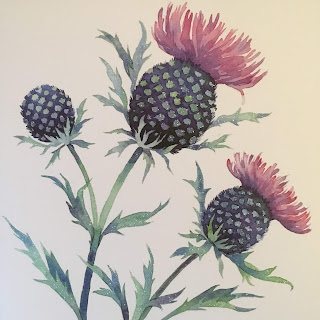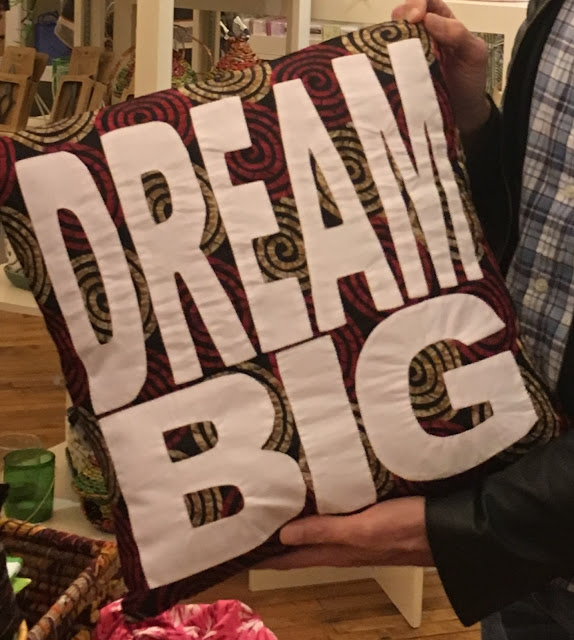Week 12: A Frosty Thistle
Today is the First Sunday of Advent. A number of people I know have a tradition of
mailing their Christmas cards at the beginning of Advent. But John (the main preparer of our Christmas letter)
and I are lucky if we get our seasonal message out before Christmas Day. I also notice that what with email, e-cards, the
cost of postage and deaths among our network of family and friends, that the
number of Christmas cards we receive has plummeted over recent years. However, as I wander the high streets of English
towns and villages the Charity Shops and pop-up stores are awash with cards for
sale for a variety of good causes. Nativity
scenes, Peace Doves, Father Christmas, festive food, wintery landscapes, red
robins, dogs with bows, squirrels in snow, wreaths on doors, Paddington Bear
and even London buses feature on some more than 500 designs for more than 70
charities ranging from Age UK and Alzheimer’s Society to World Cancer Research
Fund and Yorkshire Wildlife Trust.
As my time on Sabbatical draws to
a close it seemed appropriate to write some cards of gratitude to various
people who have hosted me, to do so in a seasonal greeting card, thereby
support one of these charities in the process.
Then the quandaries began to arise.
Do I purchase a pack of cards with
a nativity scene, when the recipients may be of another faith tradition (or
none) and graven images may cause offence?
And often the scenes as portrayed bear little resemblance to the actual
biblical stories on which they are based and even less to the (unknown)
historical truth of a baby born to parents of Middle Eastern appearnace. Do I settle for Father Christmas/ Santa Clause/
Saint Nicholas/ Kris Kringle that seems to have usurped this Christian feast? Or some innocuous Christmas trimming? The Peace Dove viewed through an arched
window, a holly plant with its bright red berries and stars twinkling in the
night sky, seems a possible compromise, but its inside message is Best Wishes
for Christmas (then after all it is Christmas that is being celebrated.)
Another influencing factor is the charity
supported by the card sale. As I
surveyed the charities represented at the pop-up shop in the New Room (The John
Wesley Chapel in Bristol and the oldest Methodist building in the world, where
I participated in their open communion service on Friday) “Cards for Good
Causes” one charity stood out, Shelter.
Shelter is a UK Charity that helps people struggling with bad housing or
homelessness providing advice, support and legal services, along with carrying
out research to understand UK’s housing problem, develop policies that offer
solutions, calls on government to tackle the causes and consequences of the
housing crisis and works with the media to ensure the voices of those affected
are heard. So, it will come as no
surprise to most of you that this was charity I was drawn to.
As the biblical story goes, Mary after
having given birth, wrapped Jesus in swaddling clothes and laid him in a manger/
feeding trough/ stall because there was no room for them in the inn/ lodging
place/ guest chamber (depending on the translation used). Homelessness is not a new problem! And it is a very obvious one in most of the
places I have visited over the past 12 weeks.
Most confronting in San Francisco because of the sheer numbers and the
level of obvious disability among those on the street. More hidden in places like Bristol but
nonetheless tents can be seen among canal banks and just off the forest paths.
Then the image I chose, The
Frosted Thistle, (photo of card at the top of this posting) for no other reason than it was the most visually appealing to
me of the 9 designs on offer (a London scene, Christmas deserts, hatted
penguins and parading tartan bears!) But
what of a thistle, the national emblem of Scotland. The thistle has prickles all over it,
protecting it from grazing animals. Some
thistles are considered weeds- maybe just an inconvenient nuisance for some or
an invasive pest best done away with by others.
Other thistles others are of economic importance, artichokes are a
species of thistle and other species are a source of rennet used in cheese
making, they are also important honey plants and a source of vegetable oil and
pharmaceutical compounds. (Thanks Wikipedia)
Much of our society may see the
homeless as a nuisance, that they would rather ignore. I know I feel uncomfortable walking past a
squat in the drizzly rain, or when a beggar asks me for loose change as I exit
the supermarket with my bag of groceries.
But I am also asking myself what is the gift that the homeless have to
offer me? How am I invited to live in a
way that sees the homeless as a valuable part of our human ecological web of
life. Can I come to know the homeless
not just in terms of their economic value (often equated as an economic drain)
but as a vital element needing to be in relationship and treated as people of
worth?
My mind wanders back to that the
inn/ lodging place/ guest chamber in Bethlehem mentioned in Luke’s infancy
narrative written some 2000 years ago and how the humble shepherds hurried there
and after their encounter with Mary, Joseph and the baby lying in the manger/
feeding trough/ stall returned to the fields glorifying and praising God for all
they had heard and seen. It seems to me
these shepherds, themselves marginalised by the social and religious elite
where the first to encounter the Divine presence in the infant Jesus. As I prepare for my retreat starting tomorrow,
a retreat that occurs both at the beginning of Advent and at the end of my
sabbatical, I wonder how the Frosty Thistle and the homeless may be inviting me
to encounter the divine presence this Christmas and beyond?





Comments
Post a Comment